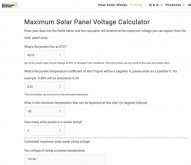Hello all. The wife and I live very off grid in Alaska (helicopter has to deliver stuff) and for the last couple of years we have lived in our 20 foot yurt powered by 16 x 100 watt Renogy panels connected into two separate Yeti 3000s. Even though the yurt location is not great for solar, it has worked wonderfully. In the winter we have had to use a generator for backup not infrequently, but it has worked well. That is the extent of our solar experience though. Few months ago, however, we came back from a trip into town to discover a brown bear had destroyed our yurt. So now we're building a small cabin this summer. Going to mount solar on the two roofs. One section angled for winter will hold 24 x 100 watt Renogy panels and the other roof will hold 30 x 100 watt panels for summer and shoulder season.
I think we want to bite the bullet and purchase three Relion RB300-LT lithium iron phosphate batteries (they take a solar charge down to -4F) as our battery bank but I have no idea what the best solar charge controller would be to charge those batteries and no idea how best to organize the panels into strings. My gut feeling is I should increase the voltage as much as possible by wiring some panels in series in order to keep the wire diameter small but I'm not really sure. One limitation with the RB300-LT batteries is that they may NOT be connected in series, but can be connected in parallel.
I do know during the winter that the winter roof 24 panels will be the only ones to get sun (terrain, trees, and low Alaska sun will keep the other 30 panels shaded).
I'm not deadset on Renogy 100 watt panels but that's what we've been using and they work well for us and are easy to work with, but our experience is limited. The specs are found here (I'm not sure if those specs limit me in any way to how many I can put in series or parallel -- my assumption is that is limited only by the charge controller):
https://www.renogy.com/100-watt-12-volt-monocrystalline-solar-panel-compact-design/
I want to make sure we get this system designed right and squeak every bit of juice from the panels into the batteries because it will be powering our electric fence to keep out the bears. My mistake in the yurt was thinking freezing temps meant the bears would be sleeping and so the lithium being unpowered (and thus the electric fence) didn't seem like a big deal. I know better now but I can't afford to learn any more lessons from bears!
Many thanks for any help with my floundering around.





